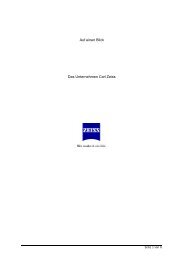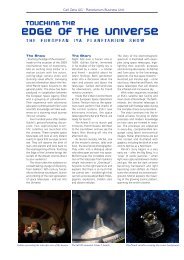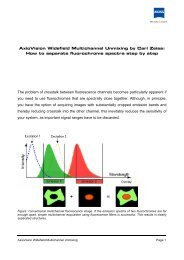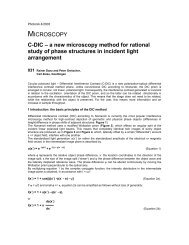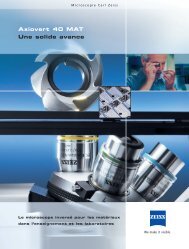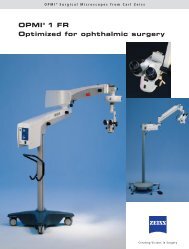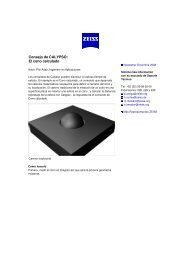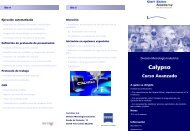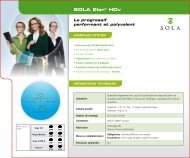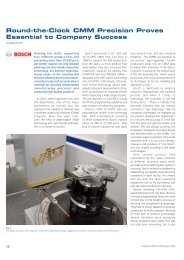Demonstration of the Advantages of Electron Beam ... - Carl Zeiss SMT
Demonstration of the Advantages of Electron Beam ... - Carl Zeiss SMT
Demonstration of the Advantages of Electron Beam ... - Carl Zeiss SMT
Create successful ePaper yourself
Turn your PDF publications into a flip-book with our unique Google optimized e-Paper software.
Advanced process capabilities for electron beam based photomask<br />
repair in a production environment<br />
Anthony Garetto 1 , Christ<strong>of</strong> Baur 2 , Jens Oster 2 , Markus Waiblinger 3 , Klaus Edinger 2<br />
1 <strong>Carl</strong> <strong>Zeiss</strong> <strong>SMT</strong> Inc., 1 Corporation Way, 01960 Peabody, MA<br />
2 NaWoTec GmbH, Industriestr. 1, 64380 Roßdorf, Germany<br />
3 <strong>Carl</strong> <strong>Zeiss</strong> SMS GmbH, <strong>Carl</strong>-<strong>Zeiss</strong>-Promenade 10, 07745 Jena, Germany<br />
ABSTRACT<br />
The cost and time associated with <strong>the</strong> production <strong>of</strong> photolithographic masks continues to grow, driven by <strong>the</strong> ever<br />
decreasing feature size, advanced mask technologies and complex resolution enhancing techniques. Thus employment <strong>of</strong><br />
a high-resolution, comprehensive mask repair tool becomes a key element for a successful production line. The MeRiT ®<br />
utilizes electron beam induced chemistry to repair both clear and opaque defects on a variety <strong>of</strong> masks and materials with<br />
<strong>the</strong> highest available resolution and edge placement precision. This paper describes <strong>the</strong> benefits <strong>of</strong> <strong>the</strong> electron beam<br />
induced technique as employed by <strong>the</strong> MeRiT ® system for a production environment.<br />
KEYWORDS: mask repair, repair tool, MeRiT ® , electron beam, <strong>Carl</strong> <strong>Zeiss</strong>, PSM deposition<br />
INTRODUCTION<br />
The cost involved in <strong>the</strong> production <strong>of</strong> photolithographic masks makes up an increasingly larger portion <strong>of</strong> <strong>the</strong><br />
semiconductor industry as <strong>the</strong> technology node decreases. The industry has currently reached <strong>the</strong> 45 nm node and <strong>the</strong><br />
International Technology Roadmap for Semiconductors (ITRS) projects that <strong>the</strong> 32 nm node will be upon us within five<br />
years 1 . In order to resolve such small features, resolution enhancement techniques (RET) such as <strong>the</strong> use <strong>of</strong> phase<br />
shifting and optical proximity correction (OPC) must be employed. Phase shift masks (PSM) are commonly used in<br />
today’s mask shop with high end shops looking ahead towards high-transmission and extreme ultra-violet (EUV). OPC<br />
involving <strong>the</strong> addition or modification <strong>of</strong> features such as scatterbars, hammerheads and serifs is ano<strong>the</strong>r commonly used<br />
RET that becomes more aggressive and intricate <strong>the</strong> smaller features become. Fur<strong>the</strong>rmore, an increase in <strong>the</strong> number<br />
and intricacy <strong>of</strong> process steps, as well as <strong>the</strong> use <strong>of</strong> more cost intensive production tools and materials has also occurred.<br />
All <strong>of</strong> <strong>the</strong>se technologies contribute to <strong>the</strong> increased complexity <strong>of</strong> photomask design and fabrication. The ability to<br />
repair photomask defects is more important than ever in order to increase yield, reduce costs and stay competitive in <strong>the</strong><br />
semiconductor industry.<br />
Although several photomask repair techniques exist, until now <strong>the</strong>re has been no single tool that can repair all defect<br />
types. Focused ion beam (FIB), laser and atomic force microscopy (AFM) based repair tools are commonly used,<br />
however each technique has its limitations. Laser based tools do not have <strong>the</strong> resolution necessary for <strong>the</strong> 45 nm node<br />
and below and only have <strong>the</strong> capability for opaque defect repair. FIB repair tools suffer from exposure damage such as<br />
ion implantation resulting in optical transmission loss (referred to as staining) and unwanted physical sputtering. These<br />
effects eliminate <strong>the</strong> ability to perform repair inspection and deposit phase-shift matching material as well as make small<br />
opaque defect repair difficult due to riverbedding and <strong>the</strong> lack <strong>of</strong> material selectivity. AFM based techniques are time<br />
consuming in <strong>the</strong> case <strong>of</strong> large defects and create debris, <strong>of</strong>ten requiring multiple cleaning procedures during a single<br />
repair. Fur<strong>the</strong>rmore <strong>the</strong>se techniques are limited by certain tight geometries and are restricted to opaque defect repair<br />
only. The need for a high-resolution, comprehensive mask repair tool is detrimental for today’s competitive production<br />
environment.<br />
The MeRiT ® electron beam mask repair tool meets this need by utilizing electron beam induced chemistry to repair both<br />
clear and opaque defects on a variety <strong>of</strong> masks with <strong>the</strong> highest available resolution and edge placement precision 2 . The
use <strong>of</strong> an electron beam eliminates radiation damage as <strong>the</strong>re is no ion implantation or physical sputtering. No debris is<br />
created due to <strong>the</strong> purely chemical nature <strong>of</strong> <strong>the</strong> process, so no cleaning steps are required. Features <strong>of</strong> <strong>the</strong> MeRiT ® such<br />
as <strong>the</strong> proprietary charge blocking method, laser interferometer, gas introduction system, pattern copy and recognition,<br />
and drift correction have previously been addressed. Fur<strong>the</strong>rmore, experimental results on <strong>the</strong> repair <strong>of</strong> some<br />
programmed defects such as opaque binary defects and clear PSM defects have also been reported 3 .<br />
This paper demonstrates <strong>the</strong> advantages <strong>of</strong> electron beam technology and presents recently developed features <strong>of</strong> <strong>the</strong><br />
MeRiT ® that seek to broaden its repair capabilities and fur<strong>the</strong>r improve yield. Both clear and opaque PSM defects are<br />
repaired and subjected to AIMS ® analysis in order to demonstrate <strong>the</strong> advantages <strong>of</strong> <strong>the</strong> electron beam technology for<br />
PSM repair. Incorporation <strong>of</strong> <strong>the</strong> above-lens energy and angle selective backscatter electron (EsB) detector for atomic<br />
number based endpointing is also introduced. Finally, in collaboration with <strong>the</strong> Advanced Mask Technology Center<br />
GmbH & Co (AMTC), several production plate defect repairs have been performed successfully to validate <strong>the</strong><br />
performance <strong>of</strong> <strong>the</strong> MeRiT ® in a true production environment.<br />
MeRiT ® CAPABILITIES AND BENEFITS<br />
The advantages <strong>of</strong> <strong>the</strong> MeRiT ® repair technology over o<strong>the</strong>r techniques lie in <strong>the</strong> use <strong>of</strong> a focused electron beam to<br />
induce chemical reactions between an adsorbed precursor and <strong>the</strong> photomask surface. Depending on <strong>the</strong> precursor<br />
chemistry and photomask material, this reaction results in <strong>the</strong> removal <strong>of</strong> volatile products in <strong>the</strong> beam irradiation area<br />
(etching) or <strong>the</strong> addition <strong>of</strong> non-volatile material (deposition). The industry proven, robust <strong>Carl</strong>-<strong>Zeiss</strong> Gemini ® electron<br />
beam column 2 with its electrostatic and electromagnetic immersion lens, provide <strong>the</strong> outstanding performance at 1 keV<br />
(with a 50 pA specimen current and spot size under 3 nm) which is required to meet <strong>the</strong> stringent requirements for this<br />
application.<br />
The use <strong>of</strong> an electron beam to induce <strong>the</strong> chemical reaction introduces no radiation damage such as physical sputtering<br />
or ion implantation. Since <strong>the</strong>re is no physical sputtering component to <strong>the</strong> repair process, physical alteration only<br />
occurs in <strong>the</strong> area irradiated by <strong>the</strong> beam when <strong>the</strong> precursor is locally introduced. In <strong>the</strong> absence <strong>of</strong> precursor gases<br />
unlimited pre- and post-repair inspection is possible with minimal degradation <strong>of</strong> <strong>the</strong> optical properties and with better<br />
resolution than many CD-SEMs. The absence <strong>of</strong> ion implantation allows <strong>the</strong> deposition <strong>of</strong> pure materials that can match<br />
<strong>the</strong> phase shift and absorption properties <strong>of</strong> any advanced PSM. The ability for quartz etching has also been realized<br />
without <strong>the</strong> deleterious effects <strong>of</strong> staining.<br />
Figure 1 shows an example <strong>of</strong> a broken line on a 193 nm 6% transmission MoSi mask that has been repaired with PSM<br />
deposition. SEM images <strong>of</strong> <strong>the</strong> defect are shown before <strong>the</strong> repair in a) and after <strong>the</strong> repair in b). AIMS ® analysis data is<br />
included in c) to make evident how well <strong>the</strong> deposited material matches <strong>the</strong> original MoSi. Note how <strong>the</strong> transmission<br />
and <strong>the</strong> through focus behavior <strong>of</strong> <strong>the</strong> CD for both <strong>the</strong> deposited line as well as <strong>the</strong> neighboring spaces closely agrees<br />
with that <strong>of</strong> <strong>the</strong> MoSi.
Figure 1 Example showing good phase and transmission matching <strong>of</strong> 193 PSM deposition process. A line break is shown a)<br />
before <strong>the</strong> deposition and b) after <strong>the</strong> deposition with AIMS data for <strong>the</strong> deposition shown in c). The AIMS data shows that<br />
<strong>the</strong> deposit matches <strong>the</strong> transmission and through focus behavior <strong>of</strong> <strong>the</strong> neighboring lines and spaces well.<br />
The above AIMS ® data has been quantified below in Table 1. The mask feature is a 1:1 line and space pattern with 360<br />
nm pitch and <strong>the</strong> reference was taken from <strong>the</strong> same line approximately one micron above <strong>the</strong> repair area. The first<br />
column shows <strong>the</strong> intensity difference for <strong>the</strong> deposited line as well as for <strong>the</strong> clear spaces to <strong>the</strong> left and right in order to<br />
elucidate <strong>the</strong> effects <strong>of</strong> <strong>the</strong> deposit to <strong>the</strong> surrounding area. The last three columns show <strong>the</strong> difference in CD measured<br />
at <strong>the</strong> mask level in nanometers below focus (-0.15 um), at focus and through focus (+0.15 um).<br />
Left Space<br />
Center Line<br />
Right Space<br />
Intensity Below Focus CD At Focus CD Through Focus CD<br />
Difference (-0.15 um) (0 um) (+0.15 um)<br />
+0.003<br />
-0.002<br />
+0.008<br />
0 nm<br />
+1 nm<br />
+6 nm<br />
+1 nm -2 nm<br />
+6 nm 0 nm<br />
-6 nm -4 nm<br />
Table 1 Summarized results <strong>of</strong> <strong>the</strong> AIMS ® data from Figure 1. The intensity and CD difference for <strong>the</strong> deposition versus a<br />
reference are tabulated for <strong>the</strong> deposited line as well as <strong>the</strong> neighboring spaces. The through focus CDs are included to give an<br />
indication <strong>of</strong> how well <strong>the</strong> phase is matched. All measurements were taken at <strong>the</strong> mask level for 180 nm lines.<br />
In addition to <strong>the</strong> in-lens SE detector, <strong>the</strong> MeRiT ® has an additional above-lens EsB detector for <strong>the</strong> collection <strong>of</strong><br />
backscattered electrons (BSEs). The above-lens EsB detector allows <strong>the</strong> etching process to be stopped between materials<br />
due to <strong>the</strong> atomic number dependence <strong>of</strong> backscattered electrons. This means opaque defects <strong>of</strong> uneven height can be<br />
fully removed without unwanted etching into <strong>the</strong> underlying layers. Major benefits <strong>of</strong> <strong>the</strong> EsB detector over typical BSE<br />
detectors are <strong>the</strong> ability to detect material contrast in low voltage applications as well as in <strong>the</strong> nanometer range, both <strong>of</strong><br />
which are important for our purposes. Fur<strong>the</strong>rmore, <strong>the</strong> detector sits above <strong>the</strong> lens which allows <strong>the</strong> possibility <strong>of</strong><br />
working at very short working distances and <strong>the</strong> ability to simultaneously use <strong>the</strong> EsB and in-lens detectors.<br />
An example <strong>of</strong> a programmed defect repair is demonstrated in Figure 2 to clarify <strong>the</strong> basic principle <strong>of</strong> <strong>the</strong> method. A<br />
single opaque bridge between two lines on a 193 nm 6% transmission MoSi mask is shown before <strong>the</strong> repair in a) and<br />
after <strong>the</strong> repair with endpointing in b). During <strong>the</strong> etching <strong>of</strong> <strong>the</strong> defect, <strong>the</strong> endpointing stops <strong>the</strong> etch process precisely<br />
at <strong>the</strong> MoSi/quartz interface, resulting in a smooth bottom.
Figure 2 Example <strong>of</strong> a 193 nm 6% transmission MoSi line and space bridge defect. The image in a) shows <strong>the</strong> bridge before<br />
etching and <strong>the</strong> resulting repair after etching is shown in b).<br />
Several significant benefits <strong>of</strong> <strong>the</strong> MeRiT ® repair technology have been discussed including <strong>the</strong> elimination <strong>of</strong> radiation<br />
damage and debris allowing pre- and post-repair imaging and inspection as well as <strong>the</strong> ability to touch up previously<br />
repaired sites thus significantly improving repair yield. The unique PSM deposition capability enables <strong>the</strong> repair <strong>of</strong> clear<br />
defects that match <strong>the</strong> transmission and through focus behavior <strong>of</strong> MoSi. This deposition was demonstrated along with<br />
<strong>the</strong> corresponding AIMS ® results. Finally, <strong>the</strong> removal <strong>of</strong> opaque defects using endpointing has been presented.<br />
EXAMPLES OF PRODUCTION ENVIRONMENT REPAIRS<br />
In order to validate <strong>the</strong> quality <strong>of</strong> repairs performed by <strong>the</strong> MeRiT ® in a true production environment, <strong>the</strong> Advanced<br />
Mask Technology Center GmbH & Co located in Dresden, Germany, has provided images <strong>of</strong> actual defect repairs on<br />
product plates performed on site. The MeRiT ® MG45 was <strong>the</strong> only repair tool used to repair <strong>the</strong>se defects. All <strong>of</strong> <strong>the</strong><br />
repairs shown below passed <strong>the</strong> specification for acceptable repair quality and were shipped to <strong>the</strong> customer.<br />
Figure 3 shows a small opaque extension on a 193 nm 6% transmission MoSi line before being repaired in a). This<br />
extension was removed using <strong>the</strong> endpointing process and <strong>the</strong> post-repair image in b) shows that <strong>the</strong> extension was<br />
completely etched without any unwanted overetching into <strong>the</strong> quartz. It can also be seen that <strong>the</strong> line edge roughness<br />
and CD has been preserved.
Figure 3 Images <strong>of</strong> an opaque 193 nm 6% transmission MoSi extension defect a) before repair and b) after etching using<br />
endpointing. Note <strong>the</strong> smooth remaining quartz left in <strong>the</strong> region <strong>of</strong> <strong>the</strong> defect.<br />
Ano<strong>the</strong>r opaque 193 nm 6% transmission MoSi defect is presented in Figure 4 below. This defect is much larger and<br />
more complex than <strong>the</strong> first as can be seen from <strong>the</strong> pre-repair image in a) showing that it consists <strong>of</strong> both a bridge<br />
between two lines as well as an extension in <strong>the</strong> neighboring space. The post repair image in b) again shows that <strong>the</strong><br />
defect has been removed without overetching into <strong>the</strong> quartz. Both sides <strong>of</strong> <strong>the</strong> line remain smooth and straight<br />
conserving <strong>the</strong> CD along <strong>the</strong> line. The post repair image scan direction has been rotated 45 degrees in order to eliminate<br />
scanning artifacts in <strong>the</strong> region <strong>of</strong> interest.<br />
Figure 4 A large line/space defect consisting <strong>of</strong> a bridge and an extension shown before repair in a). The post repair image in<br />
b) shows removal <strong>of</strong> <strong>the</strong> entire defect while line width and edge roughness are preserved. The post repair image was rotated to<br />
reduce scanning artifacts.<br />
The previous two examples demonstrate <strong>the</strong> successfulness <strong>of</strong> endpointing for full height defects, but <strong>the</strong> true benefit <strong>of</strong><br />
this technology is <strong>the</strong> ability to also repair partial height defects no matter <strong>the</strong> thickness or topography with no additional<br />
work required for <strong>the</strong> operator. The images in Figure 5 were supplied by ano<strong>the</strong>r customer site and show a partial height
248 nm 6% transmission MoSi opaque defect in a field <strong>of</strong> quartz. From <strong>the</strong> pre-repair image in a) it is evident that <strong>the</strong><br />
defect is not a full height etch block and contains a great deal <strong>of</strong> topography. The post repair image in b) shows that <strong>the</strong><br />
endpointing works very well for partial height defects, removing <strong>the</strong> entire defect while maintaining a smooth quartz<br />
surface with minimal surface roughness.<br />
Figure 5 A partial height 248 nm 6% transmission MoSi defect approximately 500 nm by 800 nm in a field <strong>of</strong> quartz shown a)<br />
before repair and b) after repair. The process resulted in a very smooth repair area that was not discernable in AIMS ® .<br />
Several examples <strong>of</strong> production environment repairs performed by <strong>the</strong> MeRiT ® have been presented to support <strong>the</strong><br />
performance and validity <strong>of</strong> <strong>the</strong> endpointing technique. This method has been employed for successful repairs on a<br />
variety <strong>of</strong> PSM and binary mask types. It is important to point out that this ability in combination with <strong>the</strong> precision and<br />
minimal contamination to <strong>the</strong> surrounding area is not available with any o<strong>the</strong>r repair technology in production today.<br />
CONCLUSION<br />
The MeRiT ® mask repair tool is <strong>the</strong> only available tool using electron beam induced chemistry technology for<br />
photomask repair. The use <strong>of</strong> an electron beam for mask repair eliminates <strong>the</strong> damage and o<strong>the</strong>r deleterious effects<br />
associated with o<strong>the</strong>r repair techniques and allows <strong>the</strong> operator virtually unlimited imaging as well as <strong>the</strong> ability to<br />
perform both opaque and clear defect repair on binary and phase-shifting masks. Fur<strong>the</strong>rmore, a single site can be<br />
repaired multiple times if necessary in <strong>the</strong> case <strong>of</strong> challenging defects or human error, thus increasing yield and<br />
contributing to <strong>the</strong> overall mask house productivity. Several examples <strong>of</strong> production defect repairs using endpointing<br />
from customer sites have been presented as well as <strong>the</strong> ability to deposit material that matches <strong>the</strong> transmission and<br />
through focus behavior <strong>of</strong> MoSi. This defines <strong>the</strong> MeRiT ® as <strong>the</strong> first comprehensive mask repair tool capable <strong>of</strong><br />
repairing all types <strong>of</strong> defects on a variety <strong>of</strong> photomasks.<br />
ACKNOWLEDGEMENTS<br />
The authors would like to thank Thorsten Krome and <strong>the</strong> Advanced Mask Technology Center GmbH & Co. located in<br />
Dresden, Germany for <strong>the</strong>ir support in providing some <strong>of</strong> <strong>the</strong> images included in this paper. Their effort is greatly<br />
appreciated.
REFERENCES<br />
[1] International Technology Roadmap for Semiconductors 2007,<br />
http://www.itrs.net/Links/2007ITRS/2007_Chapters/2007_Lithography.pdf<br />
[2] T. Liang, A. Stivers, M. Penn, D. Bald, and C. Sethi, “<strong>Demonstration</strong> <strong>of</strong> Damage-Free Mask Repair Using <strong>Electron</strong><br />
<strong>Beam</strong>-induced Processes”, Proc. SPIE Vol. 5446, 291 (2004).<br />
[3] C. Ehrlich, K. Edinger, V. Boegli, and P. Kuschnerus, “Application data <strong>of</strong> <strong>the</strong> electron beam based photomask<br />
repair tool Merit MG”, Proc. SPIE Vol. 5835, 145 (2005).<br />
[4] <strong>Carl</strong> <strong>Zeiss</strong> Nanotechnology Systems Division, http://www.smt.zeiss.com/C1256E4600305472/Contents-<br />
Frame/84E6E310B4773CB3C1256E54003A31FE



